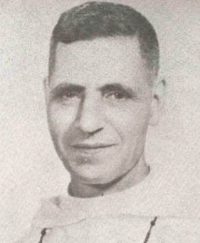I visited Muntinlupa, the new prison site. Not a political or criminal prisoner was left. When the Americans were about to arrive, they were liquidated without let-up, until the Chief henchman, disgusted with the sight of blood, shouted, “Always kill, kill. You go.” And so was saved a handful of prisoners who were already by the death wall, among whom were Fr. Rufino Santos and a boy of nine. Days before, a group of thirty were able to escape and join the guerillas.
Now the cells are occupied by the former prisoners of Los Baños who are being rehabilitated before being sent home. I heard the story of their liberation from their own lips. As I listened I could not tell whether I was listening to a detective story of Sherlock Holmes or to a script of a Hollywood comedy. They all tallied in the details of their accounts.
At dawn of the 23rd of February, the day the liberators entered Intramuros, the 250 Japanese soldiers who were guarding the prisoners of Los Baños were starting their ceremonial greetings to the sun and the Imperial palace and their routine calisthenics. From the skies, a hundred gigantic shadows fell on the ground like shadows of great scarecrows. Simultaneously, from the thicknesses of the mountains surrounding the camp emerged some two thousand guerillas who had posted themselves around the prison camp during the night. Their firings synchronized with the attack of a hundred and fifty tanks and amphibian trucks, catching the prison guards unaware and sending them scampering to the nearby bushes like scared rats. They burned the barracks and within a few minutes, the two thousand internees were moving out of the lagoon, the men on foot and the women and children in the amphibian trucks. At the beach, other vehicles were waiting for them. The enemies posted at nearby hills, who were still asleep, finally woke up and fired their artillery, wounding a soldier and a liberated internee while they were boarding the watercraft. They were the only casualties. The three-pronged attack was as spectacular as it was successful.
They crossed the lake and landed at Cabuyao which had been liberated by the guerillas. There were some fifteen thousand of them so well entrenched that now, after four weeks, they had not been displaced from those mountains. Among those liberated were seven Dominican priests, about a hundred members of other religious orders and more than two hundred sisters.
This movie-like comedy was preceded, five days earlier, by a Herodian tragedy which undoubtedly motivated the risky liberation of Los Baños. In the nearby town of Calamba, the subhuman beast had sacrificed more than six thousand persons. This was narrated to me by six priests who stayed at El Real. The shouts of the victims of bayonet thrusts could be heard in the whole town during the whole morning. In the afternoon, the priests were arrested together with other townspeople and were made to line up along the road. Their hands were tied and their eyes blindfolded. Then the atrocity! Shrieks and shoutings cried out to high heavens. After more than an hour, they brought the priests to the macabre scene. Their turn of judgment had come amidst the screams of the victims and the grunts of the beasts. They commended for the last time their souls to the Creator. They had assumed this state of resignation born of innocence, undisturbed by the mental sensation of the cold blade that was about to butcher them.
Suddenly the heinous act stopped but not the screamings. There was a long discussion among the henchmen, after which they were untied and their blindfold removed. They never found out the reason for their miraculous liberation. They could not tell whether they could attribute it the fact that the assassins got fed up with so much bloodshed, or whether one of them who was less blood thirsty, interceded in their favor.
A few days later, after trekking through forests and fields, they arrived at Santa Rosa.
Two Dominican priests and a Jay brother did not have the same luck. They were Fr. Merino and Fr. Diez who were in Los Baños. On the day the prisoners were liberated, they were taken by a Japanese and the American amphibian trucks could not wait for them. When the people in the mountains went back to the town on hearing the news that the Americans had come, the Japanese were in town waiting for them, and massacred them, the two Dominican priests included.
Massacre was committed in all towns of those provinces. In Tanauan, the hometown of Laurel, soldiers went from house to house before dawn and killed everybody they found either with bullets or with blows. Some five thousand were slain in San Pablo. The people of Lipa were ordered to evacuate. Those who failed to do so were killed. But for those who fled, soldiers were lying in wait to kill them on the way. There was a conservative count of 15,000 dead. Even those in the mountains did not escape the bloodthirsty vampires. They were hunted like beasts in barrios and mountains. Only those who succeeded in crossing to the liberated areas were saved from the diabolic fury of these children of Heaven. That was how the Bishop of Lipa and a number of priests of that diocese were saved.
Through the towns of Batangas and Tayabas which least suffered during the occupation, passed Genghis Khan in katana and Attila in kimono.
